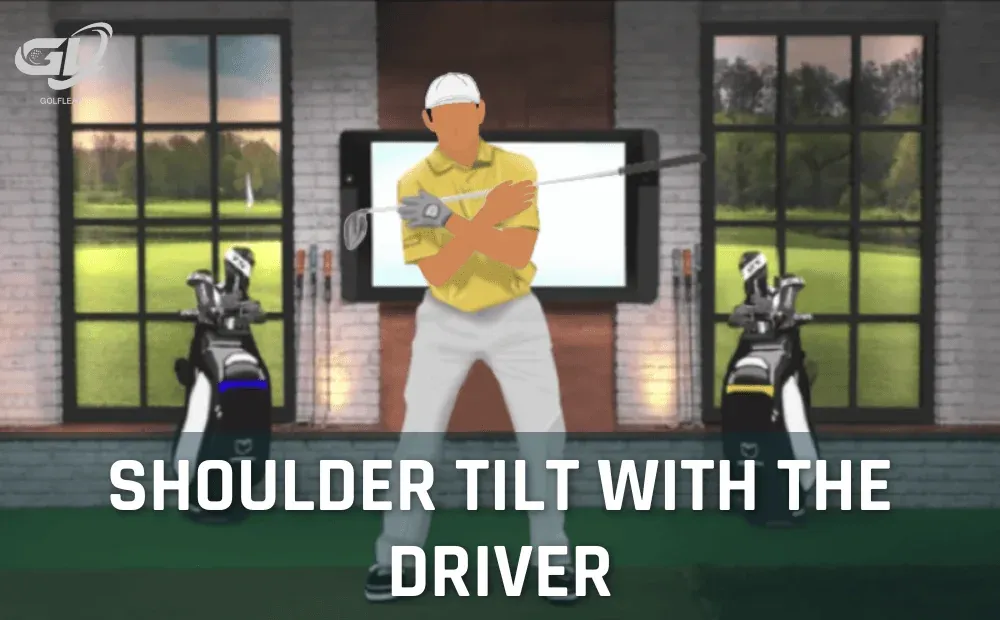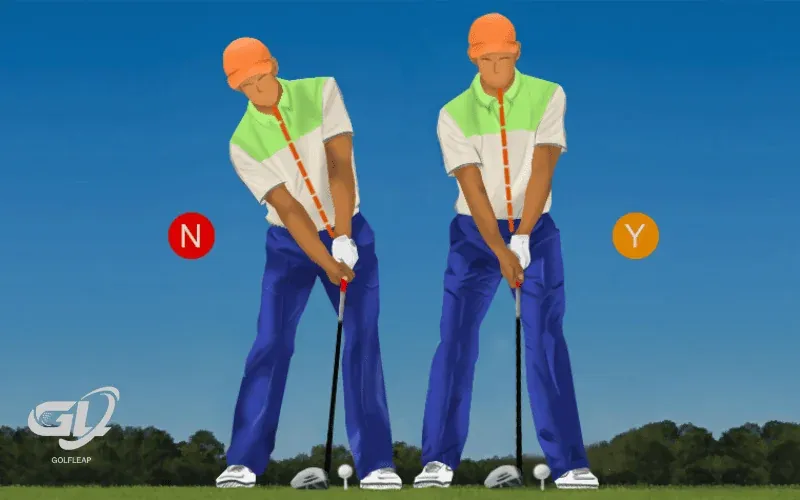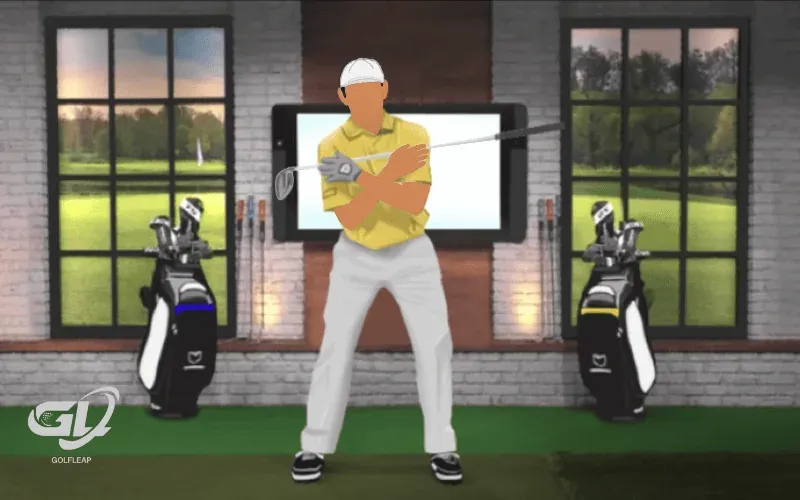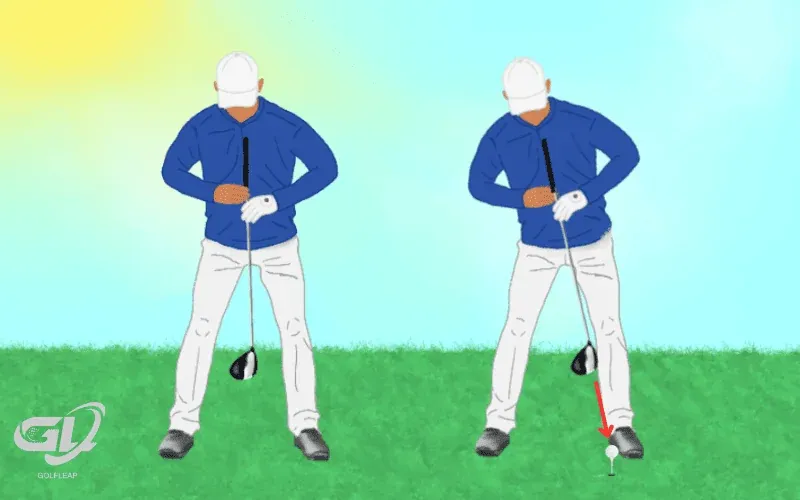
How To Create The PERFECT Amount of Shoulder Tilt With The Driver:
Hooks, slices, and low flying drives that don’t go near as far as your potential max distance off the tee. Does any of this sound familiar?
You might’ve already figured this out, but the best, most consistent drivers of the golf ball all begin their tee shots with the proper basic setup.
Our breakdown will explain the purpose of shoulder tilt with the driver, how to make sure you find YOUR perfect amount of shoulder tilt, and how establishing a solid driver setup will help propel your game to the next level!
Table of Contents
5 Tips for Perfect Shoulder Tilt With a Driver:
As we’ve discussed previously on this site, the driver swing is unique compared to every other club in your golf bag.
The driver is the longest club you have, both in its physical length and potential distance achievable, which often leads to longer, faster golf swings where more is likely to go wrong without proper guidance.
Assuming you’ve already nailed a perfect grip and know how to swing your driver confidently if you’re still experiencing inconsistent results, the likely cause could be too much or too little shoulder tilt!
1. Understanding WHY You Need Shoulder Tilt with Driver
Too little shoulder tilt (a.k.a parallel shoulders to the ground) causes an “Outside-to-In” swing path that delofts the face at impact (putting the low point of your driver swing in front of the golf ball), ultimately leading to drives that start low and slice away from your target with very little distance and TONS of spin.
Too much shoulder tilt (a.k.a shoulders pointing toward the sky too much) causes golfers to drag the club inside on their backswing and come “Over the Top” with their club path at impact, resulting in either a blocked shot or a severe hook!
The image above shows why it’s so important to have the right amount of shoulder turn with the driver. The aim is to hit up on the golf ball when you use the driver, and to do this, we must incorporate the right amount of shoulder tilt.
2. Diagnose Your Current Driver Shoulder Tilt

As you can see from the photo above, my trailing shoulder is roughly a “driver head width” lower than my leading shoulder.
This is the amount of shoulder tilt that feels comfortable to me and helps me produce higher, straighter drives.
If your shoulders look more like the left side of the above image than the right side (or my demonstration), then you have too much shoulder tilt.

A great way to test your shoulder tilt angle (if you don’t have a way to set up taking a video of your swing) is by placing a club parallel across your chest/shoulders/buttons on your shirt, and pointing the grip end towards your target.
If the grip points below the horizon, you know you don’t have enough shoulder tilt. If your grip points severely towards the sky, you know you have too much shoulder tilt!
3. Understand the Feeling of Having Not Enough and Too Much Shoulder Tilt
When you’re hitting the driver perfectly it feels like it takes little-to-no effort.
Here’s what you’ll feel with “too much” or “not enough” shoulder tilt.
Feeling of “Not Enough” Shoulder Tilt
Having too little shoulder tilt, or having your shoulders parallel with the ground during your driver swing, will cause a few uncomfortable feelings.
For starters, you’ll likely feel your weight shift towards the target during the swing (a fatal mistake that destroys all power).
You may also notice yourself subconsciously moving the ball further and further forward in your golf stance (in an attempt to add height to your drives).
Lastly, if you generally find a lot of heel-focused contact with your driver, it’s often from your club path being manipulated (Outside-to-In) and could be caused by not having enough shoulder tilt.
Feeling of “Too Much” Shoulder Tilt
Too much shoulder tilt with your driver can be a killer to both the consistency and ball flight of your tee shots.
First, you’ll likely notice the ball start to creep back closer and closer to the middle of your stance (since the low point of your golf swing is being moved further back due to your shoulder positioning).
Second, you’ll likely feel your weight shift back to your trail side significantly during the backswing (causing further inconsistency of contact).
Lastly, you’ll generally have toe-focused strikes and either “blocked” shots that start right (for righties) and continue right, or hooked shots that start right of your target and violently curve back the other direction.
4. Create a Shoulder Tilt “Checklist” to Increase Consistency
After learning my tendencies over the years, I’ve developed a checklist of a few “feelings” I try to capture on the tee that help me make sure I’m set up to hit a solid drive.
My personal checklist for hitting consistent drives includes:
- I make sure my ball position is in line with my leading armpit.
- I make sure my trailing hand is lower than my leading hand. (Part 1 of Initiating MY Comfortable Shoulder Tilt)
- I make sure the triangle created between my shoulders and hands points at the golf ball. (Part 2 of Initiating MY Comfortable Shoulder Tilt).
5. Experiment On The DRIVING RANGE
Speaking as a golfer that recently played poorly due to experimenting on the golf course, there’s nothing worse for your scores than hitting a shot you haven’t practiced prior.
If you think more or less shoulder tilt would improve your drives, go to the driving range and experiment there.
The driving range should be a place where you feel entirely comfortable to try new angles of shoulder tilt (as the results have zero impact on a “score”).
To make sure your time at the range is spent valuably, create a checklist like I’ve demonstrated above that you can rely on when it matters during your next round!
What About Shoulder Tilt With Irons?
In our experience, when we see golfers exhibit shoulder tilt with their irons, they usually have a hard time controlling the curve on the ball or they have problems hitting chunks and thinned shots.
Since irons are substantially shorter in length than drivers, shoulder tilt at setup will generally cause golfers to drag the club inside on the backswing and come “over the top” at impact for slices.
Additionally, shoulder tilt with irons often causes the “low point of your swing” (when you make impact) to become unpredictable, leading to chunks and thinned shots.
Shoulder Tilt Driver Exercise: How to Create Perfect Shoulder Tilt With The Driver

If you aren’t sure where to begin with initiating shoulder tilt, take your driver stance (with a ball tee’d up), grab your driver and place it down the center of your body (as the left side of the image above demonstrates).
Holding the driver in place against your body, point the club head towards the tee’d up golf ball.
Performing this action correctly will initiate shoulder tilt and push your pelvis towards the target, the perfect body positioning to create as much power as possible!
FAQ: Shoulder Tilt With The Driver
How do I get more shoulder tilt at impact in the golf swing?
More shoulder tilt at impact gives golfers greater control over the low point of their swing, leading to more consistency and confidence while playing.
If you want to initiate more shoulder tilt at impact, the easiest way to do it is by feeling your trailing elbow drop from the top of the backswing down towards your trailing hip/pocket area through impact.
Ben Hogan made this feeling famous and there’s photos of his belt being worn out from him practicing this move so often. If it worked for him, it’ll work for you!
What angle should your shoulders tilt with a driver?
While every golfer will experience their best results with a slightly different angle of shoulder tilt, Rory McIlroy has roughly 13° of shoulder tilt at set up, which turns into 34° at impact (right around average on the PGA TOUR).
Just because that’s what works best for Rory doesn’t mean you shouldn’t experiment with more or less shoulder tilt for your best results. For example, Dustin Johnson’s shoulder tilt at impact measures 45° and he’s one of the best drivers of all time!
Summary of Shoulder Tilt With The Driver
We hope you now feel confident in understanding why shoulder tilt is crucial to the success of your driver, how to diagnose your current amount, how we initiate our shoulder tilt, and how you can experiment confidently to find your best results.
The driver swing is so unique because everyone experiences their greatest success with slightly different versions of the proper setup we’ve explained above. Experiment with our tips and you’re well on your way to playing your best!

